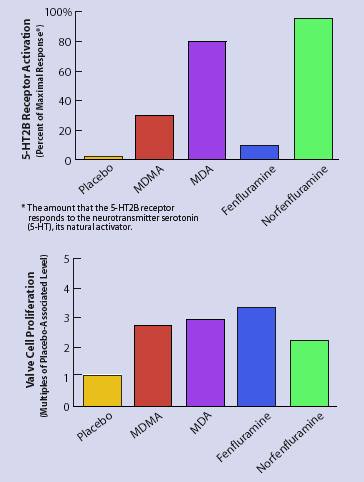Users of the club drug ecstasy (or MDMA) may be putting themselves at risk for the same type of valvular heart disease (VHD) that developed in some users of the banned diet drug fenfluramine. In a recent NIDA-funded study, researchers demonstrated in cultured heart valve cells in the laboratory that MDMA and its metabolite MDA both provoke the same abnormal activity that underlies fenfluramine-associated VHD. Although the clinical significance of the new finding is still uncertain, the intensity of the activity was similar to that associated with fenfluramine.
 MDMA Use Activates Heart Valve Receptors, Triggering Valve Cell Overgrowth. MDMA--a recipe for valvular heart disease? The top graph compares the impacts of placebo, MDMA and its metabolite MDA, and the banned diet drug fenfluramine and its metabolite norfenfluramine in activating 5-HT2B receptor sites on heart valve cells. The bottom graph shows the relative levels of valve cell proliferation in response to each.
MDMA Use Activates Heart Valve Receptors, Triggering Valve Cell Overgrowth. MDMA--a recipe for valvular heart disease? The top graph compares the impacts of placebo, MDMA and its metabolite MDA, and the banned diet drug fenfluramine and its metabolite norfenfluramine in activating 5-HT2B receptor sites on heart valve cells. The bottom graph shows the relative levels of valve cell proliferation in response to each.
The study, led by Dr. Bryan Roth, director of the National Institute of Mental Health's Psychoactive Drug Screening Program at Case Western Reserve University, showed in test tubes that MDMA and MDA activate the same 5-hydroxytryptamine 2B (5-HT2B) receptor site on heart valve cells as fenfluramine, stimulating overgrowth of heart valve cells similar to that induced by fenfluramine and its major metabolite, norfenfluramine. This overgrowth of heart valve cells in humans can lead to valvulopathy, whereby the valve becomes inefficient and blood leaks back into the heart. The chambers of the heart become overloaded with blood, enlarging the heart and impairing its ability to send blood throughout the body. If detected in time, valvulopathy can be treated with valve replacement surgery. Often, however, people with valvulopathy do not experience symptoms and some go undiagnosed for years, until they progress to heart failure.
Studies estimate that 10 to 15 percent of individuals who took the weight loss drug fenfluramine for extended periods developed VHD to some extent. In the current study, MDMA and MDA caused levels of 5-HT2B receptor site stimulation and valve cell overgrowth comparable to those produced by fenfluramine. So while it may take years for epidemiologists doing echocardiograms to confirm these test tube findings, there is evidence enough in the minds of the researchers that ecstasy users should be warned.
"As far as we're concerned, the association between 5-HT2B receptor activation and VHD is nailed down," says Dr. Roth, "and both MDMA and MDA activate this receptor site." Adds Dr. Richard Rothman, of NIDA's Intramural Research Program and one of the study's authors, "This study demonstrates that MDMA and MDA are both 5-HT2B agonists, stimulating cardiac valve cells in the laboratory to overproliferate." If this is happening in people, as Dr. Rothman suspects it may be, "these individuals would be at risk for developing VHD."
Drs. Roth and Rothman did not set out to look for an MDMA-VHD or MDA-VHD connection, but were screening both drugs to see which receptors they target. Valve cells were obtained from donor human hearts, and specimens were processed, incubated, filtered, and grown in test culture dishes. Several laboratory tests--including those for dopamine, norepinephrine, and serotonin release--were used on the cultured cells to determine MDMA's affinity for specific receptor sites and the resulting extent of valve cell proliferation. Their findings build on NIDA-funded research published in 2000 that identified how fenfluramine causes VHD. Particularly alarming, notes Dr. Rothman, is the present study's observation that MDMA and MDA stimulated 5-HT2B overgrowth at typical street doses.
In addition to testing MDMA and MDA, the researchers also screened medications known to induce VHD--pergolide, used to treat Parkinson's disease, and the migraine medication dihydroergotamine. These medications also targeted the 5-HT2B receptor site, confirming the association between this receptor site, VHD, and the ability of the laboratory tests used to identify medications that might produce VHD.
MDA, Dr. Roth observes, was more potent than MDMA in activating the VHD receptor site. "MDA is not as available to drug abusers as MDMA," he says, "probably because it's more difficult to produce. However, the individuals I've talked with who have taken both drugs seem to prefer MDA when they can get it. Whether it's MDA or MDMA, the potential for cardiac damage is real."
Sources
- Setola, V.; Hufeisen, S.J.; Grande-Allen, K.J.; Vesely, I; Glennon, R.A.; Blough, B.; Rothman, R.B.; and Roth, B.L. 3,4-Methylenedioxymethamphetamine (MDMA, "Ecstasy") induces fenfluramine-like proliferative actions on human cardiac valvular interstitial cells in vitro. Molecular Pharmacology 63(6):1223-1229, 2003. [Abstract]
- Rothman, R.B.; Baumann, M.H.; Savage, J.E.; Rauser, L.; McBride, A.; Hufisein, S.; and Roth, B.L. Evidence for possible involvement of 5-HT2B receptors in the cardiac valvulopathy associated with fenfluramine and other serotonergic medications. Circulation 102(23):2836-2841, 2000. [Full Text]
